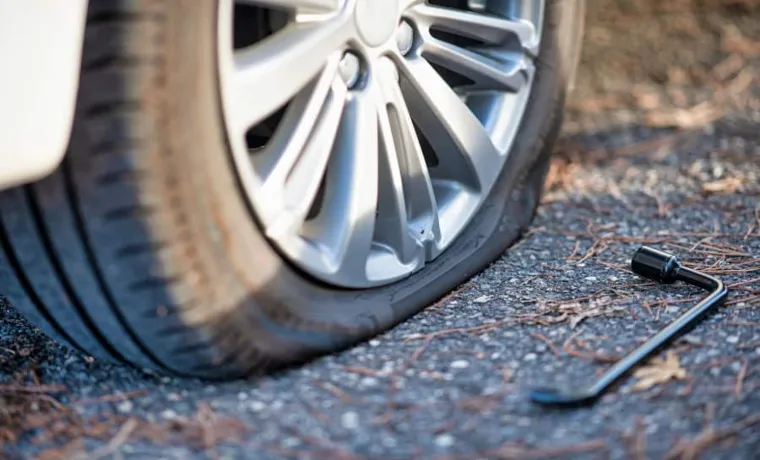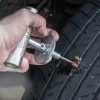Few things are worse than driving down the road and suddenly hearing that dreaded sound – the thumping of a flat tire. It’s an inconvenience that can quickly ruin your day if you’re not prepared. So, what should you do if you have a flat tire? Whether you’re a seasoned driver or just starting out, it’s always a good idea to know what to do in this situation.
In this post, we’ll guide you through the steps you need to take to get back on the road as quickly and safely as possible. From assessing the damage to calling for roadside assistance or changing the tire yourself, we’ve got you covered. So, let’s dive in and learn how to handle a flat tire like a pro!
Table of Contents
Assess The Situation
If you’re driving and suddenly feel shaking or hear a loud noise coming from your tire, you may have a flat tire. The first thing you should do is to assess the situation. Start by finding a safe place to pull over, away from traffic and onto level ground.
Make sure you use your hazard lights to alert other drivers of your situation. Once you’ve stopped your car, turn your steering wheel to ensure that your tire is visible and easy to access. Then, step out of your car and visually inspect the tire for any visible damage or signs of wear.
If you notice a puncture or tear, you may need to call for roadside assistance. If you have a spare tire and the tools necessary to replace it, carefully remove your flat tire and replace it with the spare tire. Remember to drive at a safe speed and head to the nearest tire shop to have your damaged tire repaired or replaced as soon as possible.
Find A Safe Location To Pull Over
When suddenly faced with a car problem or emergency situation while driving, it can be a scary and stressful experience. The first step you need to take is to assess the situation and determine if pulling over is necessary. If your car is experiencing mechanical difficulties or you need to make an urgent phone call, then it is best to pull over safely as soon as you can.
Take a deep breath and try to remain calm before turning on your hazard lights to signal to other drivers that you are in distress. Then, find a safe location to pull over, like the shoulder of the road or a parking lot, and be sure to put your car in park and engage the emergency brake. Remember to keep your seatbelt on while you wait for assistance to arrive.
By pulling over quickly and safely, you can minimize potential risks to yourself and other drivers on the road.

Turn On Your Hazard Lights
When driving, emergencies can arise at any moment. One of the first actions you can take when assessing the situation is to turn on your hazard lights. These flashing lights will alert other drivers on the road that you are experiencing some type of issue and need to slow down or pull over.
Turning on your hazard lights during an emergency, such as experiencing a flat tire or engine failure, can help prevent accidents and keep you safe. It’s important to remember to turn them off once the situation has been resolved as it can cause confusion for other drivers and the flashing lights can be a distraction. By using your hazard lights appropriately, you can ensure the safety of yourself and other drivers on the road.
Check If You Have A Spare Tire And Necessary Tools
Assessing the situation when experiencing a flat tire is essential for staying safe. One of the first steps you should take is checking if you have a spare tire and necessary tools to change it. It’s crucial to make sure you have the right tools because it won’t matter if you have a spare tire if you don’t have the tools to put it on.
Checking for a spare tire and tools is a quick and easy process that could save you a lot of trouble on the road. This could mean avoiding being stranded on the side of the road for several hours or even worse, getting in a dangerous situation. So before hitting the road, take a few minutes to check if all necessary tools are in your trunk and if you have a spare tire in case of an emergency.
Remember, giving your tires a once-over can prevent a roadside disaster!
Determine If The Tire Can Be Repaired Or Needs To Be Replaced
When facing a punctured tire, the first step is to assess the situation and determine if the tire can be repaired or needs to be replaced. Assessing the situation involves checking the location and size of the puncture, as well as the overall condition of the tire. If the puncture is in the tread area and is smaller than ¼ inch in diameter, it may be able to be repaired.
However, if the puncture is larger than ¼ inch, located on the sidewall, or the tire is severely damaged, replacement may be necessary. It’s important to consider the age and tread depth of the tire, as well as the type of vehicle and driving conditions, when deciding whether to repair or replace. Keep in mind that repairing a tire may only be a temporary fix and could pose safety risks in the long run.
Ultimately, consulting with a professional tire technician is the best way to determine the best course of action for your specific situation.
Change The Flat Tire
Have you ever been driving down the road and suddenly realized that your tire is flat? It can be a stressful situation, but don’t panic! The first thing you should do is safely pull over to the side of the road and turn on your hazard lights. Then, grab your spare tire, jack, and tire iron from the trunk of your car. Before jacking up the vehicle, use the tire iron to loosen the lug nuts on the flat tire.
Once you have loosened them, use the jack to lift the car until the tire is off the ground. Remove the lug nuts and the flat tire, and replace it with your spare tire. Tighten the lug nuts as much as possible, and then lower the car down to the ground.
Finally, use the tire iron to tighten the lug nuts even further in a star pattern. Congratulations, you have successfully changed your flat tire! Remember, it is important to get your flat tire repaired or replaced as soon as possible, as spare tires are not meant for long-term use.
Loosen The Lug Nuts
When you’re faced with a flat tire, the first thing you need to do is make sure your car is parked in a safe location and turn on hazard lights. Once you’ve done that, it’s time to loosen the lug nuts. These are the nuts that hold the wheel in place, and they can be quite tightly fastened.
You’ll need a lug wrench, which is usually included in your car’s toolkit. Place the wrench on one of the nuts and turn it counterclockwise to loosen it. Make sure you apply enough pressure to break the resistance.
You don’t need to unscrew it completely at this stage, just enough to loosen it up a bit. Now, move on to the other nuts, repeating the process until they’ve all been loosened. Remember to use your body weight to apply adequate pressure.
Once you’ve loosened all the nuts, it’s time to jack up the car.
Use A Jack To Lift The Vehicle
Changing a flat tire on your vehicle is a skill that every driver should have. The first step is to use a jack to lift the vehicle off the ground. Ensure that you are in a safe location before starting to change the tire.
Park the vehicle on a level surface, away from any traffic. Turn on your hazard lights to alert other drivers that you are changing a tire. Once you have safely located your vehicle, place the jack under the vehicle’s frame near the tire you need to change.
Make sure the jack is on a solid surface and that it is perpendicular to the ground. Then, pump the handle of the jack until the vehicle is high enough off the ground to remove the flat tire. Remember to always double-check that the vehicle is stable and the jack is secure before you go any further.
By following these simple steps, changing a flat tire can be a safe and easy experience on the road.
Remove The Flat Tire And Replace With The Spare
Changing a flat tire can be stressful, but with the right tools and a little know-how, it’s a simple task that you can do yourself. When you get a flat tire, the first step is to find a safe place to park your car off the road. Once you’ve done that, turn on your hazard lights and apply the parking brake.
Next, remove the damaged tire by using a lug wrench to loosen the lug nuts. Be sure to turn the wrench counter-clockwise to loosen them. Once the lug nuts are loose, jack up the car with a jack stand and remove the tire.
Finally, replace the damaged tire with the spare tire and tighten the lug nuts back in place. Remember to lower the car and remove the jack stand before driving off. With these simple steps, you can change a flat tire in no time.
So next time you get a flat tire on the road, remain calm and confidently change it yourself.
Tighten The Lug Nuts
If you find yourself with a flat tire, don’t panic! Changing a flat tire can seem overwhelming, but with a few simple steps, you can be back on the road in no time. The first step is to locate a safe place to change the tire. Move your car to the side of the road, away from traffic, and make sure it’s parked on a level surface.
Once you have your location secured, you can begin the process of changing the tire. The most critical step in this process is to tighten the lug nuts. These nuts hold the wheel to the car, so it’s essential to make sure they’re secure.
Use a lug wrench to tighten the nuts as much as possible, but be careful not to overtighten them. You don’t want to damage the studs or warp your new tire. A good rule of thumb is to tighten each nut in a star pattern, so the wheel sits flush against the car.
Once you’re confident the nuts are tight, you can pack up your tools and get back on the road. Remember, safety should always be your top priority!
Drive Carefully To A Tire Service Center
If you find yourself with a flat tire, don’t panic. The first thing you should do is carefully maneuver your vehicle to the side of the road or into a nearby parking lot. Be sure to turn on your hazard lights to alert other drivers.
It’s important to drive slowly and avoid sudden movements, as a flat tire can make your car more difficult to control. Once you’ve found a safe place to park, take a look at your tire to see if you can identify the problem. If the tire is visibly punctured or damaged, it’s best to call a tow truck.
However, if you’re close to a tire service center, you may be able to drive there slowly and have the tire repaired or replaced. Remember to always drive carefully, especially with a flat tire, to avoid causing more damage or putting yourself and others in danger.
Do Not Drive Too Far Or Too Fast On The Spare Tire
When it comes to driving on a spare tire, it’s important to remember that it’s just a temporary solution. While it may get you to the nearest tire service center, you shouldn’t push your luck by driving too far or too fast. The spare tire is not designed for long-term use, so you need to exercise caution to prevent any potential accidents.
Driving on a spare tire can affect your vehicle’s performance and handling, so it’s best to drive at a slow and steady pace. Moreover, the spare tire is usually smaller and narrower than your regular tires, which can lead to uneven wear and tear on your vehicle’s suspension. Therefore, it’s critical to get your regular tire repaired or replaced as soon as possible.
By driving carefully and safely to a tire service center, you’ll ensure the safety of yourself and others on the road. Remember, taking such precautions will not only extend the lifespan of your vehicle, but also keep you out of harm’s way.
Find A Tire Service Center To Repair Or Replace The Flat Tire
If you experience a flat tire, it’s essential to find a tire service center to repair or replace it safely. Driving with a flat tire can be dangerous and increase the risk of a blowout. To avoid causing further damage to your vehicle or jeopardizing your safety, it’s crucial to drive carefully to the nearest tire service center.
Many tire service centers offer quick and efficient services for repairing or replacing flat tires. Additionally, they can help you select the best tire replacement option based on your vehicle’s make and model and your specific driving needs. Remember to use caution when driving with a flat tire and prioritize getting to a tire service center as soon as possible to get back on the road safely.
Prevent Future Flat Tires
If you find yourself with a flat tire, the first thing to do is to stay calm and pull over to a safe spot on the side of the road. Once you have done this, check the tire to see if it can be repaired or if it needs to be replaced. Temporary repair kits are available, which can provide a quick fix to get you to a repair shop, but it’s always best to replace the tire if it is damaged or has worn down tread.
To prevent future flat tires, regularly check your tire pressure and inspect them for any signs of damage such as punctures or worn-down tread. Keep an eye on the road as well, avoiding obstacles like sharp debris or potholes. By maintaining proper tire care and being aware of any potential hazards on the road, you can help prevent flat tires from happening in the first place.
Regularly Check Tire Pressure
Flat tires are frustrating and can lead to unexpected delays or expenses. Regularly checking tire pressure can help prevent future flat tires. Low tire pressure can cause increased friction and generate excess heat, leading to blowouts.
Moreover, overinflated tires are more prone to puncturing. So, it’s essential to ensure your tires are inflated to the correct pressure, which you can find in your car’s manual or on the tire’s sidewall. Check your tire pressure at least once a month and before long trips, and don’t forget to inspect your tires for any signs of wear or damage.
Maintaining proper tire pressure not only prevents flat tires but also increases fuel efficiency, extends tire life, and ensures better handling and safety on the road. So, take care of your tires, and they will take care of you!
Avoid Driving Over Obstacles On The Road
As drivers, we encounter a variety of obstacles on the road, from potholes and debris to speed bumps and rough terrain. While some obstacles may be unavoidable, it’s important to take precautions to prevent future flat tires caused by running over objects on the road. One of the most effective ways to avoid this is to always stay alert while driving and keep a safe distance from the vehicle in front of you.
This way, you have more time to react to any objects that may be in your path. It’s also a good idea to steer clear of debris on the road whenever possible, even if it means temporarily slowing down or changing lanes. Remember, an ounce of prevention is worth a pound of cure, especially when it comes to avoiding flat tires on the road.
Replace Worn Tires Before They Become A Problem
Replacing worn tires on a regular basis can save drivers from future flat tires and other problems that may arise. While it’s easy to put off replacing old tires, it’s essential to consider safety. Driving on worn tires is risky, and it can lead to a blowout at high speeds, which can be dangerous for everyone in the vehicle.
Tires that are worn also are more susceptible to punctures and other types of damage, which can lead to expensive repairs. By investing in new tires, drivers can avoid these headaches and stay safer on the road. When considering new tires, it’s important to select ones that are suitable for the terrain and weather conditions in which they will be used.
It’s also essential to make sure the tires are properly maintained, which means checking for wear, rotating them regularly, and keeping them inflated to the recommended pressure. By taking these steps, drivers can enjoy a comfortable and safe driving experience for miles to come.
Conclusion
In the words of the wise philosopher, Beyoncé, if you find yourself with a flat tire, don’t fret, just put a spare on it. Just because life throws you a curve ball doesn’t mean you’re out of the game. Take a deep breath, grab your tools, and get to work.
And if all else fails, call a professional or a friend who can help. The important thing is to never let a flat tire deflate your spirit. Keep calm and carry on, my friends.
“
FAQs
What are the signs that I have a flat tire?
The signs of a flat tire include a thumping sound, difficulty steering, and a visible flat tire.
Can I still drive my car with a flat tire?
It is not recommended to drive your car with a flat tire as it can cause further damage to your tire and wheel, and can even lead to a potential accident.
What should I do if I have a flat tire and am on the highway?
If you have a flat tire on the highway, move to the side of the road as quickly and safely as possible. Call for roadside assistance or change the tire yourself if you have the necessary tools and experience.
How do I change a tire if I have a flat?
To change a flat tire, use a jack to lift the car off the ground and remove the damaged tire. Replace it with your spare tire and tighten the lug nuts.
What if I don’t have a spare tire?
If you don’t have a spare tire, call for roadside assistance or a tow truck to transport your car to a nearby service center.
How can I prevent a flat tire from happening?
Regularly inspect your tires for any signs of damage or wear, keep them properly inflated to the recommended PSI, and avoid driving over sharp objects or potholes.
What is the average lifespan of a tire?
The average lifespan of a tire is around 6 years, but this can vary depending on factors such as your driving habits, the climate you live in, and how well you maintain your tires.



